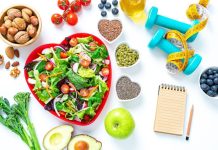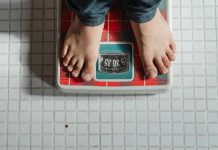How should you get started with weight loss? Firstly, take a shower, get dry and stand in front of a full-length mirror. Excess body fat around the waist and stomach is difficult to hide and is strongly linked to health problems in later life.
Secondly, measure waist-hip ratios by taking the waist measurement when standing up with tummy muscles relaxed, and divide this by the hip measurement. If it is greater than 0.85, (men 0.9) there is a need to redistribute some fat. If it is greater than 1.00, whether male or female, the issue needs addressing.
Thirdly, measure body mass index (BMI) as follows: Divide weight (kg) by height (metres squared).
The answer should lie between 18-5 and 24-9 for healthy adults, although power athletes and other sportsmen/women have unusually high BMI values due to extra muscle tissue (1).
Table of Contents
Working Out How Much Weight to Lose Over the Right Time Scale
Crash diets do not work because the human body resists sudden weight loss by adjusting its metabolic (tick-over) rate to compensate. The resulting “Yo-Yo” effect will cause weight gain rather than weight loss and destroy that all-important will power!
Plan weight loss over several months and aim to lose no more than about 1kg (2.2lbs) per month.
This is roughly equivalent to one inch off the waistline.
Choosing the Right Foods to Encourage Weight Loss
Losing 1kg of fat over one month means cutting back on calorie intake by about 300kcals per day or a total of 8400kcals over 4 weeks. This easily matches the calories in 1kg of fat (approx 7700kcals) which needs to be lost from the waistline. So how can this be done?
The foods with the most calories are oily and fatty foods followed by alcoholic drinks, including wine, beer and spirits (2). Most foods are a rich combination of fat, sugar and protein so one needs to develop a good eye for the fat content of food – and cut back on the booze.
Some fat is needed in our diet, so aim to cut back rather than cut out most of the following items:
- Creamy desserts, hard cheeses such as cheddar – and chocolates.
- Processed meats such as bacon, pork pies, sausages and burgers, meat pies and pastries.
- Cut the fat off portions of meat such as lamb, pork and beef and avoid chicken skin too.
- Any fried food contains extra oil and fat. Grill or bake instead.
- Oily fish is good for us, but extra olive oil in the salad dressing is too much of a good thing.
- Biscuits and cakes are made with fat and sugar so they taste great, but choose a lower fat alternative or eat more fruit.
- Savoury snacks including chips and crisps contain high fat levels depending on the method of food processing. Read the labels.
- Full fat milk is used in high street coffee outlets – go skinny!
- Generous amounts of butter and margarine are loaded with calories and good quality bread does not need much butter – why spoil it?
How to Identify 300kcals at Close Range
How can the body reduce daily intake by 300kcals to hit the target of 1kg weight loss in one month?
Recognise what 300kcals portions of “fatty foods” look like on a plate so that they can be avoided.
Food labels are useful as they relate to small (100g/3.5oz) portions. For example, omit any of the following to save approximately 300kcals per day. Choose fruit and low fat snacks instead.
- 2 large glasses of wine
- 1 pint of strong lager
- 4 chocolate biscuits
- 3 shortbread fingers
- 1 large Chelsea bun
- 2 hot cross buns
- 1 small slice of almost any cake
- 100g/3.5oz of most types of cheese
- 5 small chocolates
- 100ml/big squirt of whipped cream
- 1 small dollop of clotted cream
- 1 Danish pastry
- 1 medium portion of any fruit pie without custard or cream
- 2 small profiteroles
- 1 small tiramisu
Final Tips From a Nutritionist
Working with weight loss in isolation is a lonely pre-occupation, likely to fail, so share the project with close friends & family or work colleagues.
Eating smaller portions of everything has a profound effect on energy intake, so consider using smaller plates. Go small instead of BIG!
Liquid meals such as soups delay hunger pangs for longer – and eat them slowly, not on the move!
References
- Bean A (2006) The Complete Guide to Sports Nutrition. A & C Black.
- Stanford D (1999) The Fat, Fibre and Carbohydrate Counter. Murdoch Books.



